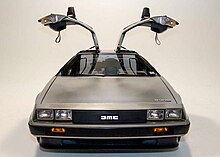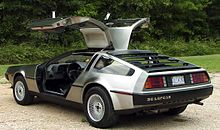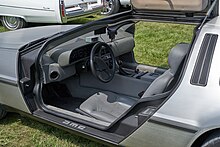DeLorean Motor Company
Detroit, Michigan[3] , U.S. | |
| Products | DMC DeLorean |
|---|---|
Production output | 9000 (estimated) |
The DeLorean Motor Company (DMC) was an American
The DeLorean was featured in the Back to the Future film trilogy (1985, 1989, and 1990) as the car made into a time machine by eccentric scientist Doc Brown, although the company had closed before the first film was made.
In 1995, Liverpool-born mechanic Stephen Wynne founded the DeLorean Motor Company (Texas),[5] an entirely new company not related to the original, located in Humble, Texas, and shortly thereafter acquired the remaining parts inventory,[6][7] and registered his own stylized version of the "DMC" logo trademark of DeLorean Motor Company (Texas).[8]
History
This section needs additional citations for verification. (September 2021) |
Beginning
John DeLorean founded the DeLorean Motor Company in
DeLorean also sought lucrative incentives from governments and economic organizations to pay for manufacturing facilities by looking to build his first factory in an area of particularly high unemployment. The
Manufacturing facility

In October 1978, construction of the six-building, 660,000 sq ft (61,000 m2) manufacturing plant began in Northern Ireland. It was designed and managed by Brodie & Hawthorn Architects of Belfast, and constructed in 16 months by Farrans, McLaughlin & Harvey. A test/proving track was also constructed next to the factory. Officially known as DMCL (DeLorean Motor Cars, Ltd.), the facility was located in The Cutts in Dunmurry, a suburb on the south-western edge of Belfast.
The combined efforts of quality assurance improvements at the factory and the post-production quality assurance done at the QACs were generally successful, although workmanship complaints still occasionally arose; the 1981 DeLoreans were delivered with a 12-month, 12,000 mi (19,000 km) warranty. By 1982, improvements in components and the more experienced workforce meant that production quality was vastly improved. Disputes between dealerships and customers arose later because many dealerships refused to do warranty work because they were not reimbursed.
Downturn and bankruptcy
The lack of demand,
John DeLorean lobbied the British Government for aid, but was refused unless he was able to find a matching amount from other investors. What followed is a matter of debate between the British Government, the US Federal Bureau of Investigation (FBI), the Drug Enforcement Administration (DEA), DeLorean, his investors, and the US court system. At some point in 1982, John DeLorean became the target of an FBI sting operation designed to arrest drug traffickers. He was arrested in October 1982 and charged with conspiring to smuggle $24 million worth of cocaine into the US. The key element of evidence for the prosecution was a videotape showing DeLorean discussing the drugs deal with undercover FBI agents Benedict (Ben) Tisa and West, although DeLorean's attorney Howard Weitzman successfully demonstrated to the court that he was coerced into participation in the deal by the agents who initially approached him as legitimate investors. He was acquitted of all charges, but his reputation was forever tarnished. After his trial and subsequent acquittal, DeLorean quipped, "Would you buy a used car from me?"
In the end, sufficient funds could not be raised to keep the company alive. DMC went bankrupt in 1982, taking with it 2,500 jobs and over $100 million in investments. The British Government attempted to revive some usable remnants of the manufacturing facility without success, and the Dunmurry factory was closed. DeLorean himself retired in New Jersey, and the dream with which he had mesmerized Britain's Labour government, of industry rising out of the ashes of The Troubles in Northern Ireland, was shattered. He claimed that the DMCL was deliberately closed for political reasons, and at the time of closing was a solidly viable company with millions of dollars in the bank and two years of dealer orders on the books.
Approximately 9,000 cars were made between January 1981 and December 1982, although actual production figures are unclear and estimates differ. Some of the cars manufactured in 1982, but not shipped to the states (as the US arm of DMC had no money to 'buy' the cars from the factory in Northern Ireland), with 15XXX and 16XXX Vehicle Identification Numbers are actually 1982 models that were given later VINs, dated 1983, by Consolidated International (now known as Big Lots), a company that had a buyback program with DMC and had bought out the remaining unsold cars and also the inventory of unused parts left in the factory after the bankruptcy.
The DeLorean assembly plant was eventually occupied by the French automotive supplier Montupet, which began to manufacture cast aluminum cylinder heads for automobile engines at the Dunmurry facility in 1989.
Vehicles
Production vehicles
DeLorean



The DeLorean (known internally during development within DMC as the DMC-12[12][13][14][note 1]) was the only car produced by DMC. Reception was mixed. Although the early vehicles had impressive waiting lists of prospective buyers, the MSRP of $25,000 (equivalent to approximately $70,000 in 2019) was prohibitive for most of the market—especially for what many considered an under-powered and impractical plaything.[by whom?] "It's not a barn burner," observed Road & Track, "(with) a 0–60 mph time of 10.5 seconds. Frankly, that's not quick for a sports/GT car in this price category." The stainless steel body panels were attractive and impervious to corrosion, but the sheen surface tended to show fingerprints and meant the car could not be easily painted; every DeLorean looked identical. Some dealerships painted their cars to make them distinctive. DMC tested translucent paint for different color options while allowing the stainless steel grain to show through, but no cars were sold with factory painted body panels. The only factory option initially available was automatic transmission. A grey interior was offered later in 1981 as an alternative to the standard black. Accessories such as pinstriping and luggage racks provided further individuality.[15]
A DeLorean was prominently featured in the 1985 film Back to the Future and its two sequels, in which it was converted into a time machine. The DeLorean time machine entered popular culture and played a major role in the continued popularity of the model.[16][17]
Concepts
DMC-24
The DMC-24 was a proposal for a 4-seater
DMC-44
The DMC-44 was a proposal for a lightweight
DMC-80
The DMC-80 was a proposal for a bus which was mooted in the fall of 1981, with a variety of 6-cylinder engines and transmissions. The company produced a promotional brochure for public transit corporations. The bus would have been an Americanized German low-floor bus produced in the United States.[18][26][27]
Notes
- ^ The DMC-12 designation was a pre-production moniker and was not used in official sales or marketing material for the production car.
References
- ^ a b Suddath, Claire (19 April 2012). "The DeLorean's Time Leap". Bloomberg Businessweek. Archived from the original on 20 May 2013. Retrieved 4 September 2019.
- ^ "DeLorean Motor Files Bankruptcy". The New York Times. 26 October 1982. Archived from the original on 6 March 2019. Retrieved 13 November 2019.
- ^ "John DeLorean Heritage Tour". DeLorean Motor City. 2007. Archived from the original on 23 January 2012.
DMC offices in Detroit were located in this office complex at 100 West Long Lake Rd in Bloomfield Hills, MI
- ^ "DeLorean Acquitted of All Criminal Finance Charges". Los Angeles Times. 17 December 1986. Archived from the original on 3 August 2020.
- ^ "Back to the future as DeLorean goes electric". BBC News. 1 April 2012.
- Automobile. Archived from the originalon 20 January 2012. Retrieved 1 April 2012.
- ^ Archived at Ghostarchive and registered his own Wayback Machine : You can still buy a brand new DeLorean, straight from the factory. CNET. 16 April 2015 – via YouTube.
- ^ "DeLorean Motor Company".
- ^ "Montupet set for expansion as company is sold for £629m". Belfasttelegraph. 22 April 2016. Archived from the original on 29 July 2020.
- ^ McDonnell, Francess. "Bright future at old DeLorean plant in Belfast". The Irish Times.
- ^ Schuetze, Pamela Barbaglia (15 October 2015). "Canada's Linamar buys French auto parts maker Montupet". Reuters.
- ^ Wills, Barrie (2015). John Z, the DeLorean & Me: Tales from an Insider. DeLorean Garage. p. 4:
My stories cover the years during which the production DeLorean (code-named DMC-12) was created, manufactured and sold.
- ^ "Seventeenth Board Meeting of De Lorean Motor Cars Limited". DeLorean Museum. 30 October 1979. p. 2. Retrieved 7 September 2021.
- ^ Lander, D. H. (22 April 1981). "Managing Director's Report No.35". DeLorean Museum. p. 2. Retrieved 7 September 2021.
- ^ Misc. Information / Pictures.
- ^ Limer, Eric (21 October 2015). "Here Are the Schematics For the 'Back to the Future' DeLorean Time Machine". Popular Mechanics.
- ^ Blumberg, Yoni (7 June 2018). "This $750,000 replica of the 'Back to the Future' DeLorean looks great—there's just one problem". CNBC.
- ^ a b c Petrány, Máté (11 April 2013). "The Proposed DeLorean Sedan Is As Coke-Tastically '80s As You'd Imagine". Jalopnik.
- ^ "The Only Custom Built 4-Seat "DMC-24" DeLorean". Build of the Week. Season 1. Episode 1. 14 September 2018. Youtube.
- ^ "Dmc-24 sedan sketches". The DeLorean Museum. 2018.
- ^ Petrány, Máté (12 April 2013). "The Secret History Of The DeLorean That Became A Lamborghini Sedan". Jalopnik.
- ^ Wills, Barrie (2015). John Z, the Delorean & Me: Tales from an Insider. DeLorean Garage. p. 103.
- ^ Branch, Ben (8 November 2022). "John DeLorean's 1976 Lohr Fardier 4×4 Is For Sale". Silodrome. Retrieved 1 January 2023.
- ^ Archived at Ghostarchive and the Wayback Machine: DeLorean Motor Company (1979). DMC-44 - The DeLorean off-road vehicle. Youtube. DeLorean Museum.
- ^ Torchinsky, Jason (10 March 2017). "DeLorean Once Considered Building This Amazing Tiny Off-Road Vehicle". Jalopnik.
- ^ "Dmc-80 Bus Brochure". The DeLorean Museum. 2018.
- ^ DeLorean DMC-80 Brochure (DeLorean Motor Company). Babb Technology.
Further reading
- John Z. DeLorean, Ted Schwarz, Delorean, Zondervan (1985), ISBN 0-310-37940-7
- Ivan Fallon, ISBN 0-399-12821-2
- William Haddad, Hard Driving : My Years with John DeLorean (1985), ISBN 0-394-53410-7
- J Lamm, DeLorean Stainless Steel Illusion, 2nd edition (2003), ISBN 0-9744141-0-7
- R. M. Clarke, Delorean 1977–1995 Gold Portfolio (D1995), ISBN 1-85520-331-6
- Brownlow, Graham. Soft Budget Constraints and Regional Industrial Policy: Reinterpreting the Rise and Fall of De Lorean, Queen's University Belfast, October 2014
- (in Italian) Granturismo Group S.r.l., Granturismo #6 (January–March, 2005), ISSN 1721-1271
- Wills, Barrie (2015). John Z, the Delorean and Me: ... Tales from an Insider. DeLorean Garage. ISBN 978-0985657888.
- Parnham, Chris; Withers, Andrew (2014). DeLorean Celebrating the Impossible. DeLorean Motor Cars (1978) Ltd. ISBN 978-0-9928594-0-4.
External links
- DeLorean Motor Company at Curlie
